Mangalagiri Panakala Narasimha Swamy Temple
The Panakala Narasimha Swamy Temple is one of the three temples dedicated to Lord Vishnu in his Narasimha avatar, located in Mangalagiri, Andhra Pradesh. This temple sits on the hill, while the Lakshmi Narasimha Swamy Temple is located at the foot of the hill, and the Gandala Narasimha Swamy Temple is at the top of the hill.
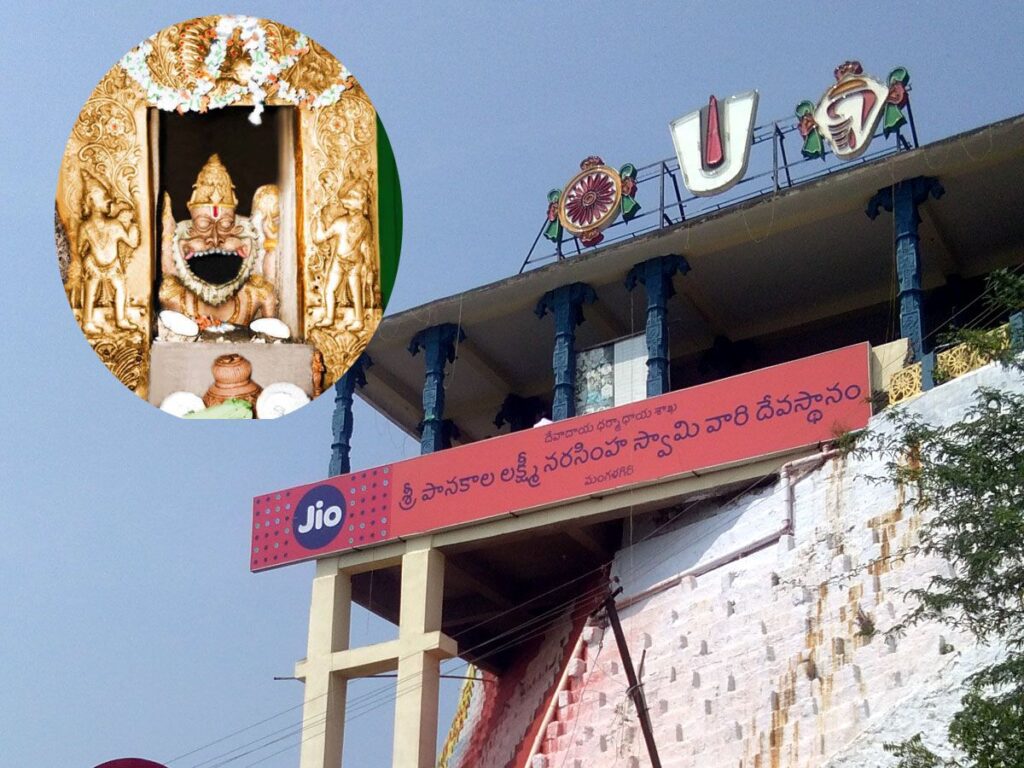
Contents
- 1 Mangalagiri Panakala Narasimha Swamy Temple History:
- 2 Legend of Mangalagiri Panakala Narasimha Swamy Temple:
- 3 Significance of Mangalagiri Panakala Narasimha Swamy Temple:
- 4 Myths and Beliefs of Mangalagiri Panakala Narasimha Swamy Temple:
- 5 Panakala Narasimha Swamy Temple Mystery:
- 5.0.1 Mangalagiri Panakala Narasimha Swamy Temple
- 5.0.2 Vontimitta Temple of Sri Kodanda Rama Swamy
- 5.0.3 Arasavalli Temple | Sri Suryanarayana Swamy Temple
- 5.0.4 Powerful Annavaram Temple Sri Veera Venkata Satyanarayana Swamy
- 5.0.5 Antarvedi Lakshmi Narasimha Swamy Temple
- 5.0.6 Kapila Theertham Temple Tirupati
- 6 Mangalagiri Panakala Narasimha Swamy Temple Timing and Rituals:
- 7 Places to visit near Mangalagiri Panakala Narasimha Swamy Temple:
- 8 How to reach Mangalagiri Panakala Narasimha Swamy Temple:
Mangalagiri Panakala Narasimha Swamy Temple History:
Legendary Origins
According to popular legend, the temple’s origins are linked to the epic Mahabharata. It is believed that the eldest Pandava brother, Yudhishthira, discovered the temple site while performing penance. The legend narrates that Yudhishthira was instructed by a divine voice to dig at a particular spot, and upon doing so, he unearthed a self-manifested idol of Lord Narasimha. This discovery marked the establishment of the Panakala Narasimha Swamy Temple.
Historical References
While legends provide a captivating narrative, historical records also shed light on the temple’s past. Inscriptions found at the temple site suggest that the temple existed as early as the 11th century CE. These inscriptions, belonging to the Chalukya dynasty, indicate that the temple was patronized by the rulers of the time.
Vijayanagara Era
The temple’s prominence grew during the Vijayanagara Empire, which ruled over the region from the 14th to the 17th centuries. The Vijayanagara kings were ardent devotees of Lord Narasimha and contributed significantly to the temple’s development. They constructed various structures within the temple complex, including the majestic gopuram (gateway tower).
Later Patronage
Following the decline of the Vijayanagara Empire, the temple continued to receive patronage from local rulers and wealthy individuals. The temple’s architecture and ornamentation reflect the contributions of various dynasties and patrons over the centuries.
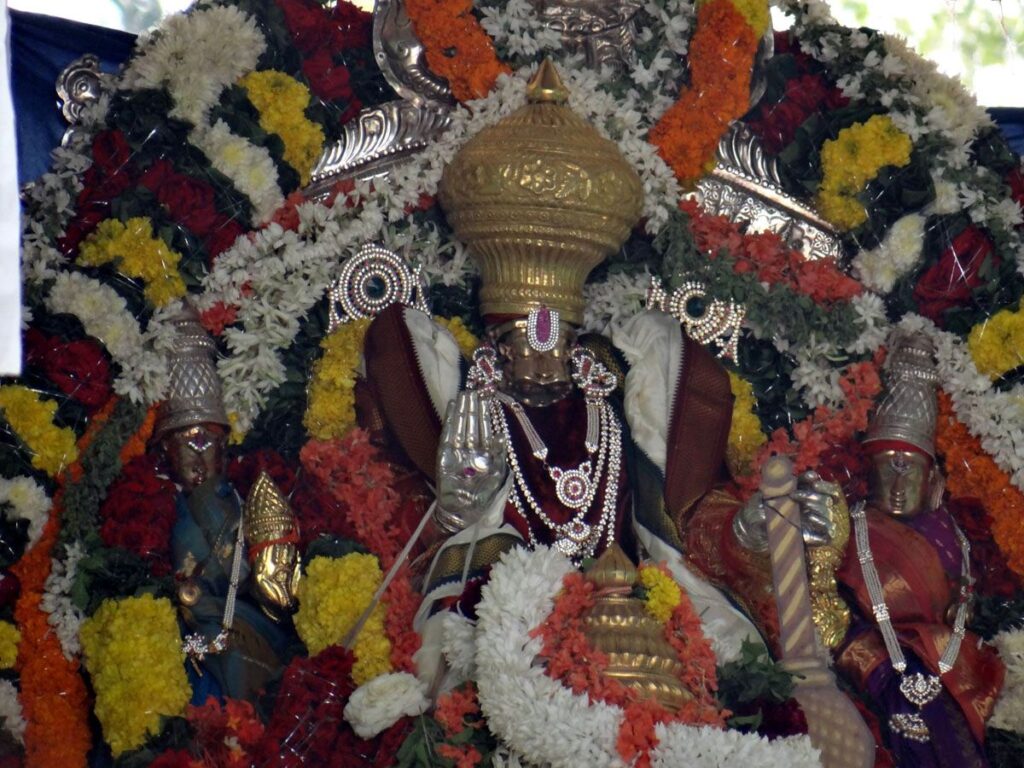
Legend of Mangalagiri Panakala Narasimha Swamy Temple:
The Wrath of Narasimha
In the Hindu epic Mahabharata, Hiranyakasipu, a powerful demon king, sought to become immortal. He subjected his people to tyranny and forbade the worship of any god except himself. His son, Prahlada, however, remained an ardent devotee of Lord Vishnu. This enraged Hiranyakasipu, who attempted to kill Prahlada on numerous occasions.
Finally, in a pillar-splitting incident, Lord Vishnu emerged as the half-man, half-lion Narasimha to vanquish Hiranyakasipu. Narasimha’s anger was so fierce that he tore Hiranyakasipu apart, leaving him lifeless.
Despite the demise of the evil king, Narasimha’s rage remained unabated. His anger was so intense that the entire universe trembled. The gods, fearing for the world’s safety, sought to pacify Narasimha.
Seeking Solace in Mangalagiri
Lord Shiva, accompanied by other deities, approached Narasimha, pleading him to calm his fury. They suggested that he move to Mangalagiri, a tranquil hill, to find solace and peace.
Narasimha, still consumed by anger, agreed to go to Mangalagiri. However, his anger was so intense that the hill could not bear its weight and began to shake. To prevent further destruction, the gods requested Narasimha to manifest himself in a less ferocious form.
Panakala Narasimha: The Appeased Deity
Narasimha, heeding the gods’ plea, transformed into a more serene form, with a wide-open mouth and a gentle expression. This form of Narasimha came to be known as Panakala Narasimha, meaning “Narasimha who drinks panakam.”
Panakam, a sweet drink made with jaggery water, cardamom, and other spices, became an offering to appease the deity. Devotees would pour the panakam into Narasimha’s open mouth, and it was believed that the Lord would drink it, symbolizing his acceptance of their devotion.
The Abode of Panakala Narasimha
Panakala Narasimha found solace in Mangalagiri, and the hill became his permanent abode. The Panakala Narasimha Swamy Temple was built to enshrine the deity, and it has since become a revered pilgrimage site, attracting devotees from far and wide.
The legend of Panakala Narasimha Swamy Temple serves as a reminder of Lord Vishnu’s power and the importance of devotion and appeasement. It also highlights the transformative nature of anger, which can be channeled into a more positive force when guided by faith and understanding.
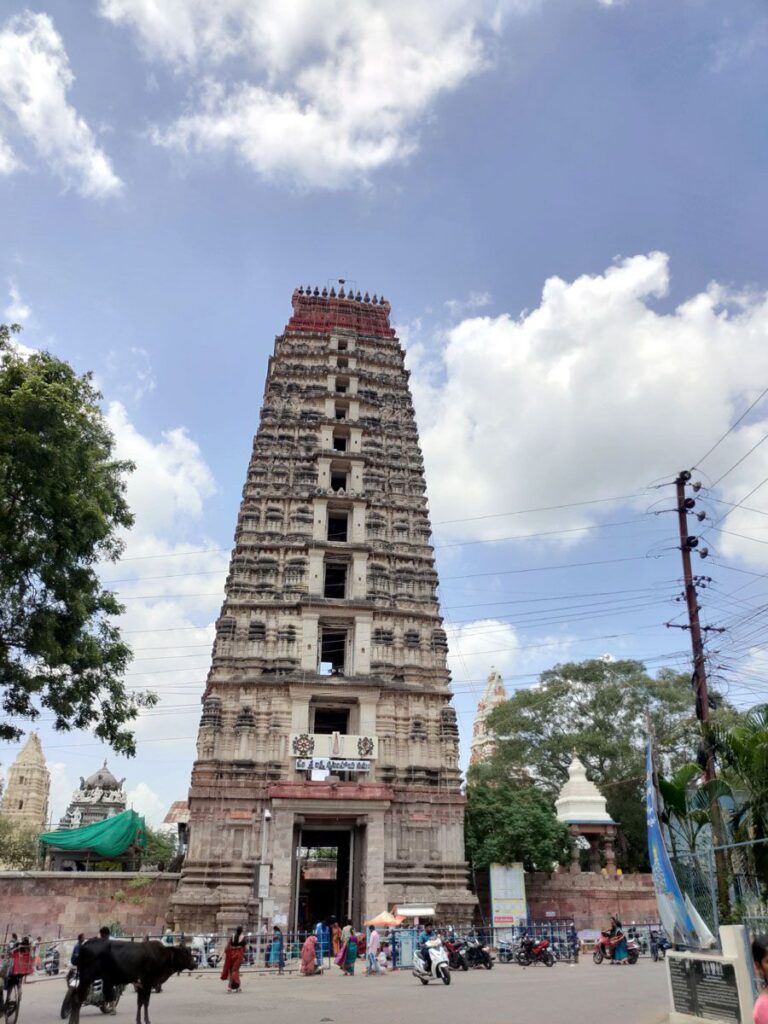
Significance of Mangalagiri Panakala Narasimha Swamy Temple:
elevates its status among Narasimha shrines.
Lakshmi Devi’s Penance: Legend has it that Goddess Lakshmi performed penance on the hill where the temple stands. This association with the goddess of wealth and prosperity adds to the temple’s allure for devotees seeking blessings for material and spiritual well-being.
Unique Deity and Offering: The temple’s main deity, Sri Panakala Narasimha Swamy, is depicted with a large open mouth, covered by a golden crown. Devotees offer a unique prasad (offering) of “panakam,” a sweet drink made with jaggery water, cardamom, and spices. This offering is believed to symbolize the quenching of the Lord’s thirst and anger, representing the pacification of negative forces.
Auspicious Location: The temple’s location on Mangalagiri Hill, meaning “auspicious hill,” further enhances its sacredness. The hill itself is believed to possess positive spiritual vibrations, making it a conducive place for spiritual seekers.
Architectural Beauty: The temple structure exudes architectural brilliance, showcasing intricate carvings and sculptures that depict various Hindu mythological scenes. The temple’s Gopuram (gateway tower) stands tall, adding to its visual grandeur.
Festivals and Rituals: The temple is a vibrant hub for religious celebrations, particularly during the Vaikunta Ekadashi festival. Devotees throng the temple to participate in various rituals and pujas (prayers), seeking blessings and spiritual fulfillment.
Devotional Significance: The temple holds immense devotional significance for devotees of Lord Vishnu, particularly those seeking protection from evil forces, removal of obstacles, and attainment of spiritual liberation. The deity’s fierce form is believed to instill fearlessness and empower devotees to overcome challenges.
Cultural Heritage: The temple is deeply embedded in the cultural heritage of Andhra Pradesh, representing the region’s rich Vaishnava traditions and devotion to Lord Narasimha. It serves as a place of pilgrimage and spiritual solace for countless devotees.
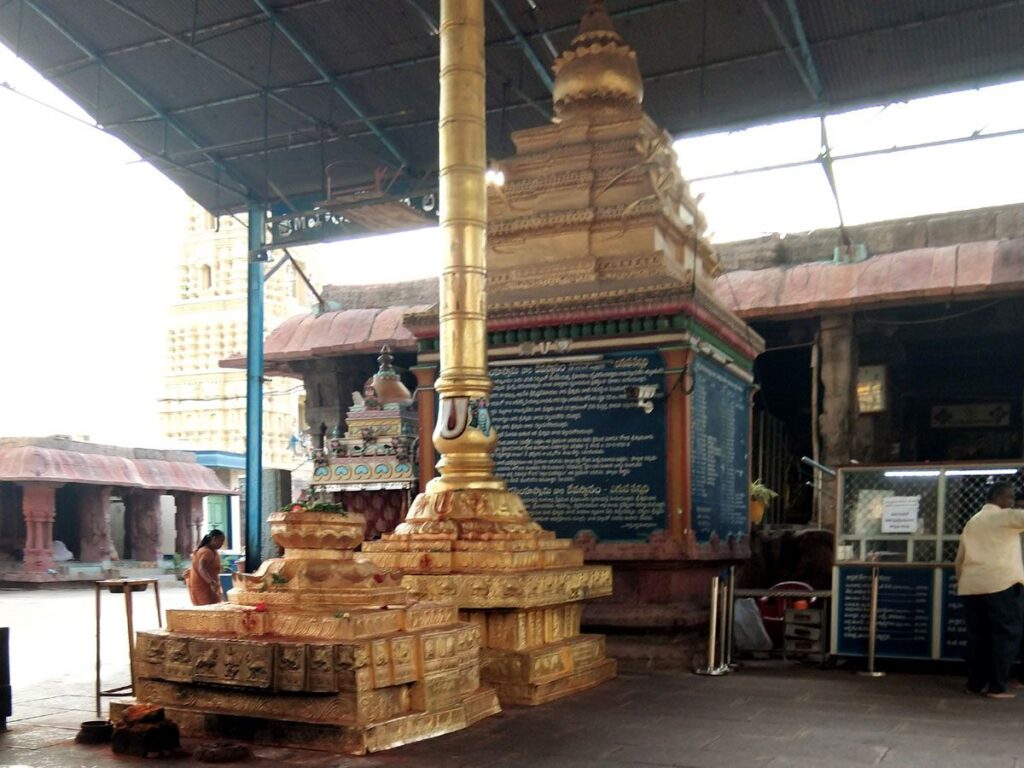
Myths and Beliefs of Mangalagiri Panakala Narasimha Swamy Temple:
Lakshmi Devi’s Penance: Legend narrates that Goddess Lakshmi, the consort of Lord Vishnu, performed penance on the hill where the temple now stands. She sought to appease Lord Vishnu and regain his favor after he had transformed into the fierce Narasimha avatar to slay the demon Hiranyakashipu. Devotees believe that the temple’s location is imbued with the divine energy of Lakshmi Devi’s penance, making it a powerful place for seeking blessings related to wealth, prosperity, and marital harmony.
Panakala Offering: The temple’s unique offering of “panakam,” a sweet drink made with jaggery water, cardamom, and spices, holds deep symbolic significance. It is believed to represent the quenching of Lord Narasimha’s thirst and anger, symbolizing the pacification of negative forces and the restoration of balance. Devotees offer panakam with devotion, seeking the Lord’s protection from evil and the bestowal of inner peace.
Auspicious Hill: The temple’s location on Mangalagiri Hill, meaning “auspicious hill,” further enhances its sacredness. The hill itself is believed to possess positive spiritual vibrations, making it a conducive place for spiritual seekers. Devotees believe that the hill’s energy amplifies the temple’s sanctity and facilitates spiritual connection.
Protection from Evil: The temple’s main deity, Sri Panakala Narasimha Swamy, is depicted in a fierce form with a large open mouth, covered by a golden crown. This ferocious representation is believed to instill fearlessness in devotees and symbolize the Lord’s power to protect them from evil forces and obstacles. Devotees seek blessings from the deity for protection, courage, and the removal of negative influences.
Spiritual Liberation: The temple is also associated with the pursuit of spiritual liberation (moksha). Devotees believe that the temple’s sacred atmosphere and the deity’s blessings can guide them on the path to spiritual enlightenment and freedom from the cycle of rebirth. The temple’s rituals and pujas (prayers) are seen as means to connect with the divine and progress on the spiritual journey.
Wish Fulfillment: The temple is believed to be a place where wishes are granted. Devotees from all walks of life come to the temple with prayers and offerings, seeking the Lord’s blessings for their personal desires, including success in their endeavors, good health, and harmonious relationships. Mangalagiri Panakala Narasimha Swamy temple’s atmosphere of faith and devotion fosters belief in the power of prayer and the possibility of divine intervention.
Connection to Ancestors: The temple is also seen as a place where devotees can connect with their ancestors. It is believed that the temple’s sacred energy can facilitate communication with departed loved ones and offer solace to those grieving their loss. Devotees may perform rituals or offer prayers at the temple to honor their ancestors and seek their blessings.

Panakala Narasimha Swamy Temple Mystery:
- The Unyielding Rage: Legend says the temple enshrines Lord Narasimha, the fierce avatar of Vishnu, who emerged to vanquish the demon king Hiranyakasipu. Even after defeating the demon, Narasimha’s rage couldn’t be contained. It is believed his anger caused the underlying hill to become an inactive volcano. To appease him, devotees offer a special jaggery water concoction called “panakam.”
- The Gurgling God: Mangalagiri Panakala Narasimha Swamy Temple’s main idol is unique. Only the face, specifically the mouth, is visible. Worshippers offer the panakam directly into the open mouth. Devotees claim to hear a gurgling sound as if the Lord himself is drinking the offering.
There are scientific explanations for these phenomena. The gurgling sound could be caused by air pockets escaping the liquid as it’s poured. The inactive volcano story might be a metaphorical representation of Narasimha’s fury.
Mangalagiri Panakala Narasimha Swamy Temple Timing and Rituals:
Timings
- Morning:
- 7:00 AM – Opening of the temple doors
- 7:00 AM – 7:30 AM – Morning Archana (worship)
- 7:30 AM – 1:00 PM – Special Archana for devotees and offering Panakam (sweet drink)
- 1:00 PM – Maharnivedana (offering of food to the deity)
- Afternoon:
- 3:00 PM – Closing of the temple doors
Rituals
Morning Archana:This is the first ritual of the day and involves offering prayers and flowers to the deity. Devotees can also offer panakam, a sweet drink made with jaggery water, cardamom, and spices.
Special Archana:This is a more elaborate puja (prayer) that can be performed by individual devotees or groups. The puja typically includes chanting of mantras, offering of flowers, fruits, and other items, and abhishekam (sacred bathing of the deity).
Panakam Offering:The offering of panakam is a unique and significant ritual at the Mangalagiri Panakala Narasimha Swamy Temple. Panakam is believed to represent the quenching of Lord Narasimha’s thirst and anger, symbolizing the pacification of negative forces and the restoration of balance. Devotees offer panakam with devotion, seeking the Lord’s protection from evil and the bestowal of inner peace.
Maharnivedana:This is the offering of food to the deity. The food is typically prepared in the temple kitchen and includes a variety of vegetarian dishes. Devotees can participate in the Maharnivedana by offering a donation or simply by witnessing the ritual.
For detailed information please visit https://www.mangalagiri.org/temple.html
Places to visit near Mangalagiri Panakala Narasimha Swamy Temple:
- Undavalli Caves: Located about 13 kilometers from Mangalagiri, Undavalli Caves are ancient rock-cut caves adorned with intricate sculptures and carvings. The caves date back to the 4th to 5th centuries AD and are known for their architectural beauty.
- Kanaka Durga Temple: Situated in Vijayawada, approximately 14 kilometers from Mangalagiri, Kanaka Durga Temple is dedicated to Goddess Kanaka Durga, a form of the Hindu goddess Durga. The temple is perched atop Indrakeeladri Hill and offers panoramic views of the surrounding landscape.
- Prakasam Barrage: Located in Vijayawada, around 16 kilometers from Mangalagiri, Prakasam Barrage is a scenic dam built across the Krishna River. Visitors can enjoy leisurely walks along the barrage and admire the river views.
- Bhavani Island: Situated on the Krishna River, Bhavani Island is a popular tourist destination near Vijayawada, approximately 20 kilometers from Mangalagiri. The island offers boating, water sports, and lush greenery, making it an ideal spot for a day trip.
- Manginapudi Beach: Located about 75 kilometers from Mangalagiri, Manginapudi Beach is a serene beach destination known for its black soil and scenic beauty. Visitors can relax on the beach, indulge in water sports, or enjoy local seafood delicacies.
- Amaravati: Approximately 30 kilometers from Mangalagiri, Amaravati is an ancient town known for its Buddhist heritage. The town houses the famous Amaravati Stupa, an ancient Buddhist monument dating back to the 3rd century BC.
- Undavalli Rock Cut Caves: These caves are about 13 kilometers from Mangalagiri. These caves are an excellent example of Indian rock-cut architecture, featuring intricate carvings and sculptures.
How to reach Mangalagiri Panakala Narasimha Swamy Temple:
By Air: The nearest airport to Mangalagiri is Vijayawada Airport (also known as Gannavaram Airport), located approximately 30 kilometers away. From the airport, you can hire a taxi or use public transportation to reach Mangalagiri.
By Train: The nearest railway station to Mangalagiri is Mangalagiri Railway Station itself, which is well-connected to major cities in India. From the railway station, you can hire an auto-rickshaw or taxi to reach the temple, which is located about 2 kilometers away.
By Road: Mangalagiri is well-connected by road to major cities in Andhra Pradesh and neighboring states. You can reach Mangalagiri via National Highway 16 (NH16) or State Highway 2 (SH2). Mangalagiri Panakala Narasimha Swamy Temple is situated in the heart of Mangalagiri town, and you can easily find local transportation options like buses, auto-rickshaws, and taxis to reach the temple once you’re in the town.

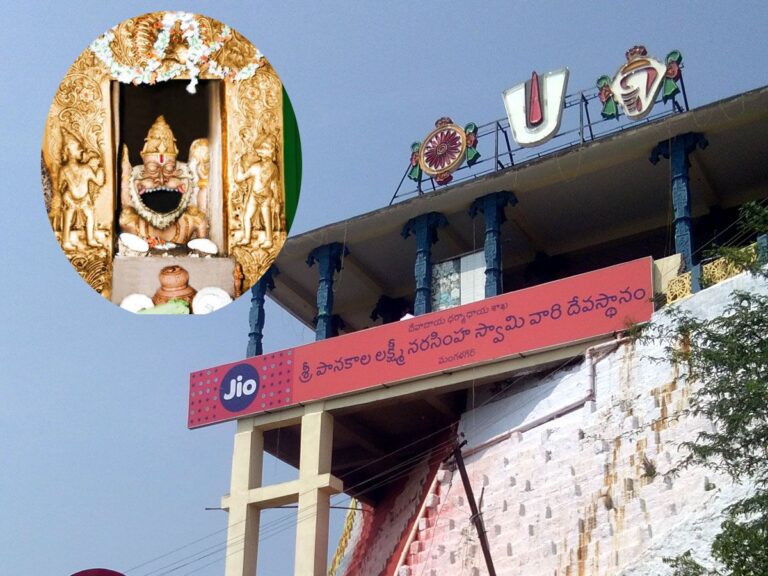



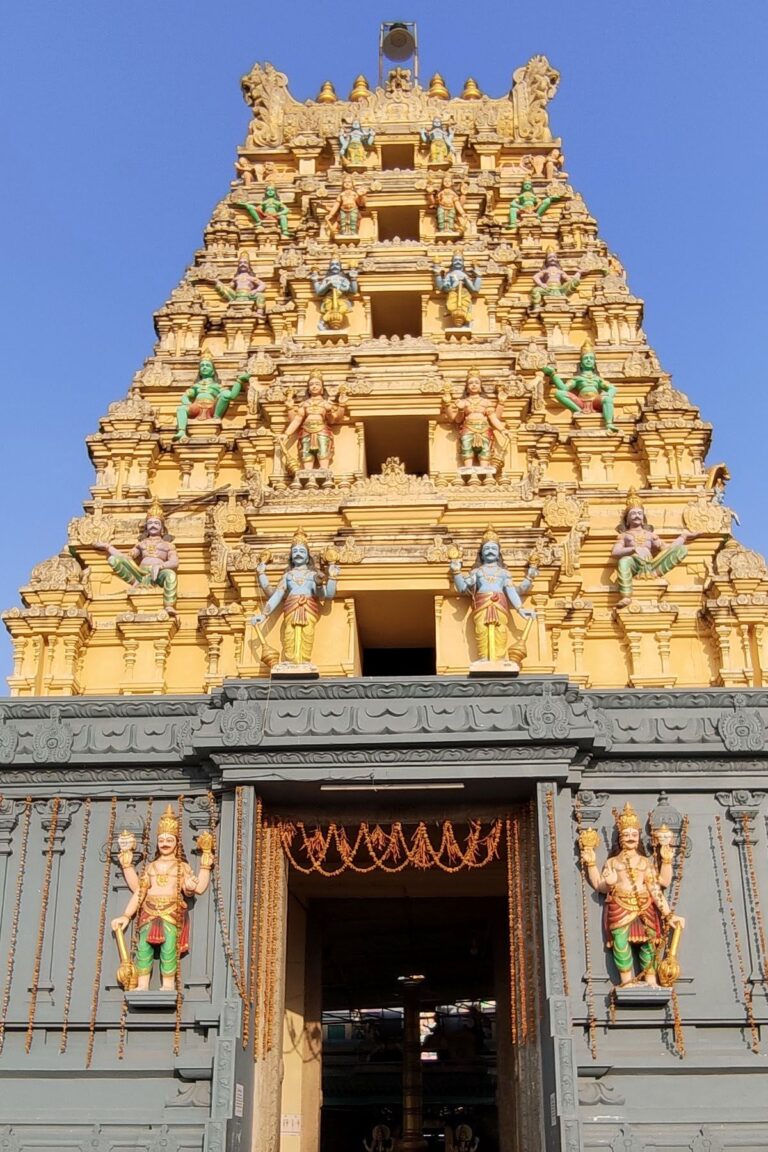



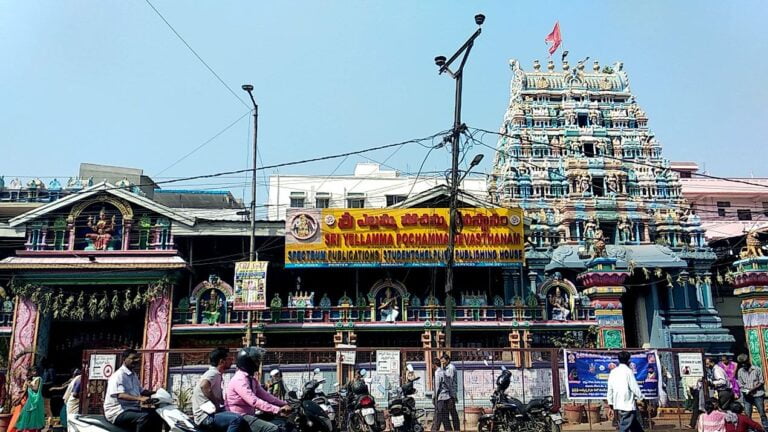



One Comment